I am considering buying a 4.6 with a tech package. I see that the standard rimss are 18 x 7. Does anyone know what size is the maximum that you can put on a genesis? Can I use 20 x 8.5 or 20 x 10 all around. Or can the size be even bigger. Also, I am hearing about offset. What is that and what is the stock offset. Also has anyone changed their rims on the genesis yet ?
-

-
Hint: Use a descriptive title for your new message
If you're looking for help and want to draw people in who can assist you, use a descriptive subject title when posting your message. In other words, "I need help with my car" could be about anything and can easily be overlooked by people who can help. However, "I need help with my transmission" will draw interest from people who can help with a transmission specific issue. Be as descriptive as you can. Please also post in the appropriate forum. The "Lounge" is for introducing yourself. If you need help with your G70, please post in the G70 section - and so on... This message can be closed by clicking the X in the top right corner.
- Genesis Forums
- Hyundai Genesis Sedan Forums - 3.8 V6, 4.6 V8, 5.0
- Detailing, Lighting and Appearance
You are using an out of date browser. It may not display this or other websites correctly.
You should upgrade or use an alternative browser.
You should upgrade or use an alternative browser.
Bernie
Getting familiar with the group...
Here are pictures of a black Genesis (Korean) previously posted and photoshoped with various custom rims.
Attachments
-
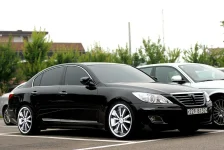 Korean Genesis-2-Petrol Nixon1.webp63 KB · Views: 357
Korean Genesis-2-Petrol Nixon1.webp63 KB · Views: 357 -
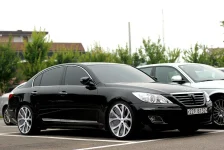 Korean Genesis-2-EXE KonKave1.webp62.2 KB · Views: 316
Korean Genesis-2-EXE KonKave1.webp62.2 KB · Views: 316 -
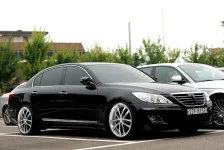 Korean Genesis-2-EXE Konvex.webp62.4 KB · Views: 295
Korean Genesis-2-EXE Konvex.webp62.4 KB · Views: 295 -
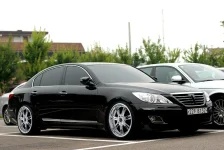 Korean Genesis-2-Avarus AV4.webp62.9 KB · Views: 285
Korean Genesis-2-Avarus AV4.webp62.9 KB · Views: 285 -
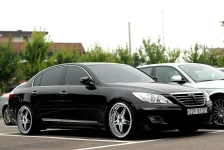 Korean Genesis-2-Avarus AV5.webp62.5 KB · Views: 267
Korean Genesis-2-Avarus AV5.webp62.5 KB · Views: 267 -
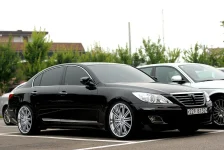 Korean Genesis-2-Bayern Baroque.webp63.3 KB · Views: 267
Korean Genesis-2-Bayern Baroque.webp63.3 KB · Views: 267 -
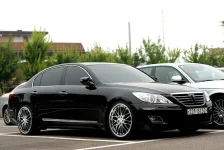 Korean Genesis-2-MRR GT1.webp63.3 KB · Views: 274
Korean Genesis-2-MRR GT1.webp63.3 KB · Views: 274 -
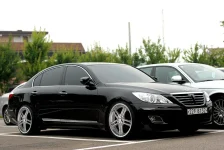 Korean Genesis-2-MRR GT2.webp61.9 KB · Views: 265
Korean Genesis-2-MRR GT2.webp61.9 KB · Views: 265 -
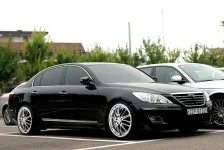 Korean Genesis-2-Privat Motiv.webp63.1 KB · Views: 271
Korean Genesis-2-Privat Motiv.webp63.1 KB · Views: 271 -
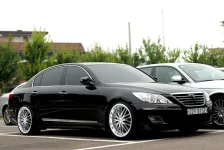 Korean Genesis-2-TSW Snetterton.webp62.9 KB · Views: 291
Korean Genesis-2-TSW Snetterton.webp62.9 KB · Views: 291
GS300rich
Been here awhile...
20s will definately fit. Just a matter of how wide the rear tires will be. The front tires are already 245, and it looks like the rear could hold a 10.5 or 11" rear wheel and a 285 or maybe even a bit bigger with the right offset. I would love to see a nice staggered setup with a meaty 285 rear tire 
Bernie
Getting familiar with the group...
The wheel requirements for the Genesis are 5x114.3 (4.5"), with an offset ranging from +35 to +45. On my Genesis, the original wheels are Dunlop SP 500 tires P235/50R18 with 18" rims. If you go to Tirerack.com and select Hyundai Genesis, and then select original equipment, the Dunlop tires specs indicate that the overall diameter is 27.1" (770 revs/mile).
If you wish to upsize to 19", you need to adjust the tire profile to a P245/40R19; this ensures that the overall wheel diameter (rim + tire) ends up being close to original rim/tire overall total diameter. As a result, your odometer precision ends up pretty well unchanged. With this rim/tire arrangement, the overall diameter ends up at 26.9" (774 revs/mile).
Likewise, if you wish to upsize to 20", you will need to adjust the tire profile to a 255/35ZR20. With this rim/tire arrangement, the overall diameter ends up at 27" (774 rev/mile).
Final note: if you go to Tirerack.com, you will notice that there are slight variations in tire sizes between manufacturers even if they share the same tire designation (e.g. Pxxx/xxRxx)
If you wish to upsize to 19", you need to adjust the tire profile to a P245/40R19; this ensures that the overall wheel diameter (rim + tire) ends up being close to original rim/tire overall total diameter. As a result, your odometer precision ends up pretty well unchanged. With this rim/tire arrangement, the overall diameter ends up at 26.9" (774 revs/mile).
Likewise, if you wish to upsize to 20", you will need to adjust the tire profile to a 255/35ZR20. With this rim/tire arrangement, the overall diameter ends up at 27" (774 rev/mile).
Final note: if you go to Tirerack.com, you will notice that there are slight variations in tire sizes between manufacturers even if they share the same tire designation (e.g. Pxxx/xxRxx)
VaiFan
Been here awhile...
be forewarned, a 19-20" wheel will not only make the ride more harsh, but also due to the increased weight (unsprung weight) will tax your shocks and springs much more, thereby decreasing handling performance.
Yes, you get a bigger contact patch resulting in more grip, but it makes it much harder for the suspension to keep that heavier wheel smoothly intact with the pavement.
In other words, you are sacrificing actual performance and ride for "bling".
Yes, you get a bigger contact patch resulting in more grip, but it makes it much harder for the suspension to keep that heavier wheel smoothly intact with the pavement.
In other words, you are sacrificing actual performance and ride for "bling".
Bernie
Getting familiar with the group...
Anyone interested in a tiresize calculator....
The calculator provides you with total wheel diameter dimensions (rim + tire) and allows you to make comparisons between stock wheels and alternates wheels.
http://www.miata.net/garage/tirecalc.html
The calculator provides you with total wheel diameter dimensions (rim + tire) and allows you to make comparisons between stock wheels and alternates wheels.
http://www.miata.net/garage/tirecalc.html
Looking to update and upgrade your Genesis luxury sport automobile? Look no further than right here in our own forum store - where orders are shipped immediately!
Bernie
Getting familiar with the group...
Bernie
Getting familiar with the group...
Lord_Nikon
Hasn't posted much yet...
Just remember about rotational mass and its effect on preformance and ride.
Oh ya here is another clean Hyundai with a decent wheel and tire setup
http://fatlace.com/hellaflush/?p=20
Oh ya here is another clean Hyundai with a decent wheel and tire setup
http://fatlace.com/hellaflush/?p=20
GS300rich
Been here awhile...
love the flush look in your link Lord Nikon, thanks for the links to the calculators bernie, I was looking for one of them. If I am not mistaken a 295-30-20 is the same height as the 255-35-20. I would love to see this on the rear of a genesis.
GS300rich
Been here awhile...
be forewarned, a 19-20" wheel will not only make the ride more harsh, but also due to the increased weight (unsprung weight) will tax your shocks and springs much more, thereby decreasing handling performance.
Yes, you get a bigger contact patch resulting in more grip, but it makes it much harder for the suspension to keep that heavier wheel smoothly intact with the pavement.
In other words, you are sacrificing actual performance and ride for "bling".
This is not completely true. If you have a forged wheel that is lightweight it will actually weigh less than the OEM. On my lexus my wheels are pounds lighter on each corner. If you use a chromed out bling bling wheel then yes you will have extra weight on each wheel and that will wreak havoc on your suspension and brakes and such. But a high quality lightweight wheel is the way to go when going larger than OEM.
DieselHybrid
Getting familiar with the group...
- Joined
- Dec 22, 2008
- Messages
- 40
- Reaction score
- 0
- Points
- 0
Just think how much more rotational mass you would reduce by going to smaller diameter forged wheels!
As the old saying goes, "beauty is in the eye of the beholder."
When I see mega-sized wheels on a car I think, "Poor guy has no idea how those bling wheels are hurting his performance (acceleration, deceleration, fuel economy)- not to mention the added stresses on the vehicle's dynamic components."
My intention would be to buy the lightest forged 17" wheels that would fit the Genesis. Sure, it might not look as "bling" as other rides- but I'm more interested in function over something as fickle as "bling."
Freedom of choice also includes the freedom to be ignorant of the laws of Physics. But to each his own.
Peace.
As the old saying goes, "beauty is in the eye of the beholder."
When I see mega-sized wheels on a car I think, "Poor guy has no idea how those bling wheels are hurting his performance (acceleration, deceleration, fuel economy)- not to mention the added stresses on the vehicle's dynamic components."
My intention would be to buy the lightest forged 17" wheels that would fit the Genesis. Sure, it might not look as "bling" as other rides- but I'm more interested in function over something as fickle as "bling."
Freedom of choice also includes the freedom to be ignorant of the laws of Physics. But to each his own.
Peace.
crepen
Getting familiar with the group...
Freedom of choice also includes the freedom to be ignorant of the laws of Physics. But to each his own.
Good thing you live in a free country
If it were that simple, F1 cars would ride on 115/95R12s or something ridiculous like that.
Note in the following I highlight CAN, since your mileage may vary based on car, quality of aftermarket parts chosen, and your personal preference as far as appearance, ride and performance characteristics.
Increasing tire width and decreasing sidewall height CAN bring tangible performance benefits as well.
In general, bigger wheels CAN provide better acceleration, decelleration and steady state handling, typically at the expense of top speed, handling on rough surfaces and "ride"
Mass is a significant input into the equation, but it is not the only one.
regards,
cmr
Lord_Nikon
Hasn't posted much yet...
To a point. but for the most part in the real world. all it does is make a car ride worse.Increasing tire width and decreasing sidewall height CAN bring tangible performance benefits as well.
Not really bigger wheels have greater mass which kill all preformance.In general, bigger wheels CAN provide better acceleration, decelleration and steady state handling, typically at the expense of top speed, handling on rough surfaces and "ride"
now if you said lighter wheel then you would be right.
Mass is a significant input into the equation, but it is not the only one.
regards,
cmr
Mass and tire compound make up 90% of it. That and tire contact patch and the driver.
DieselHybrid
Getting familiar with the group...
- Joined
- Dec 22, 2008
- Messages
- 40
- Reaction score
- 0
- Points
- 0
@ Crepen-
"If it were that simple, F1 cars would ride on 115/95R12s or something ridiculous like that."
I think you would be surprised to learn that F1 cars don't use 22" wheels for the very reasons I outlined in my original post: acceleration, deceleration, cornering. F1 and Indy cars use smaller 15"-18" forged magnesium wheels that are just large enough to house carbon-ceramic disc brakes within their inner perimeter, with the rules size requirement being placed on the outside tire diameter. In the case of Indy cars that is 26"/27" f/r.
However, you're ignoring what matters most: the aspect ratio (length x width) of the tire's contact patch. A 17x9" (245/50/17) contact patch aspect ratio would be preferred over a 22x9" (235/30/22)- not just for performance but also for ride quality, comfort and rim security.
Also, when using oversized "bling" wheels, the smallest sidewalls (35-30 series) must be used in order to preserve nearly the same tire/wheel diameter as stock. As a result, the contact patch aspect ratio may actually suffer when compared to the stock wheel/tire combo.
So, you may think you "look" cool with "bling" wheels- but you just can't fool Physics; performance will suffer.
Peace.
"If it were that simple, F1 cars would ride on 115/95R12s or something ridiculous like that."
I think you would be surprised to learn that F1 cars don't use 22" wheels for the very reasons I outlined in my original post: acceleration, deceleration, cornering. F1 and Indy cars use smaller 15"-18" forged magnesium wheels that are just large enough to house carbon-ceramic disc brakes within their inner perimeter, with the rules size requirement being placed on the outside tire diameter. In the case of Indy cars that is 26"/27" f/r.
However, you're ignoring what matters most: the aspect ratio (length x width) of the tire's contact patch. A 17x9" (245/50/17) contact patch aspect ratio would be preferred over a 22x9" (235/30/22)- not just for performance but also for ride quality, comfort and rim security.
Also, when using oversized "bling" wheels, the smallest sidewalls (35-30 series) must be used in order to preserve nearly the same tire/wheel diameter as stock. As a result, the contact patch aspect ratio may actually suffer when compared to the stock wheel/tire combo.
So, you may think you "look" cool with "bling" wheels- but you just can't fool Physics; performance will suffer.
Peace.
Last edited:
crepen
Getting familiar with the group...
DieselHybrid,
Your points are valid, and I actually had an indy tire as a coffee table at one point so I am aware of their dimensions (those suckers are heavier than they look). The point I was trying to make is that there is no absolute "small good/big bad" or vice versa - it is relative to the original configuration.
I find it hard to believe that car manufacturers continue to go to bigger and bigger wheels, particularly on high-performance cars, if smaller wheels was a simple solution. Porsche certainly knows more about this than you or I, and they don't use 15" wheels.
The "stock" setup of cars is designed by the manufacturer to achieve a certain balance of performance and ride. Aftermarket parts, including changing the tire size can alter that balance.
Factors such as wheel and tire manufacture/material, sidewall stiffness, tire pressure, temperature and, as you stated, most importantly the driver, have more weight overall than simple math regarding tire profile.
A 235mm wide tire on a 17" wheel *may* have a bigger contact patch, based on sidewall stiffness and tire pressure, it may not. Compound and tread design will tell whether that bigger patch does any goes, either sideways or straight ahead.
Lastly, whether it be engineering or market forces, try finding a 285mm wide 17" tire.
I agree fully that anyone throwing 45lb 20" wheels with budget tires on their car, hoping for performance improvements, is wasting their time, but carefully selecting high-quality components to match your desired vehicle performance is one way to personalize your vehicle.
Let's agree that "bling" is different than substance, but I won't be putting skinny 16" tires on my baby anytime soon.
Your points are valid, and I actually had an indy tire as a coffee table at one point so I am aware of their dimensions (those suckers are heavier than they look). The point I was trying to make is that there is no absolute "small good/big bad" or vice versa - it is relative to the original configuration.
I find it hard to believe that car manufacturers continue to go to bigger and bigger wheels, particularly on high-performance cars, if smaller wheels was a simple solution. Porsche certainly knows more about this than you or I, and they don't use 15" wheels.
The "stock" setup of cars is designed by the manufacturer to achieve a certain balance of performance and ride. Aftermarket parts, including changing the tire size can alter that balance.
Factors such as wheel and tire manufacture/material, sidewall stiffness, tire pressure, temperature and, as you stated, most importantly the driver, have more weight overall than simple math regarding tire profile.
A 235mm wide tire on a 17" wheel *may* have a bigger contact patch, based on sidewall stiffness and tire pressure, it may not. Compound and tread design will tell whether that bigger patch does any goes, either sideways or straight ahead.
Lastly, whether it be engineering or market forces, try finding a 285mm wide 17" tire.
I agree fully that anyone throwing 45lb 20" wheels with budget tires on their car, hoping for performance improvements, is wasting their time, but carefully selecting high-quality components to match your desired vehicle performance is one way to personalize your vehicle.
Let's agree that "bling" is different than substance, but I won't be putting skinny 16" tires on my baby anytime soon.
Great products:
- VIN Check
- Add more horsepower!
- Clean your leather!
- Safe Emergency Charging
- Windshield Repair Kit
- Chemical Guys HydroSpeed Ceramic Quick Detailer
- Chemical Guys HydroCharge High-Gloss Hydrophobic SI02 Ceramic Spray Coating
- Get a dash cam!
- Auto Buyers Market
- Foreign invaders vs USA gangs
- VIN Check
- Add more horsepower!
- Clean your leather!
- Safe Emergency Charging
- Windshield Repair Kit
- Chemical Guys HydroSpeed Ceramic Quick Detailer
- Chemical Guys HydroCharge High-Gloss Hydrophobic SI02 Ceramic Spray Coating
- Get a dash cam!
- Auto Buyers Market
- Foreign invaders vs USA gangs
Featured content
-
-
Thread 'Help us to keep helping you. Your support is essential to our survival.'
- Sal Collaziano
Replies: 27





